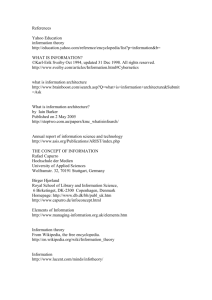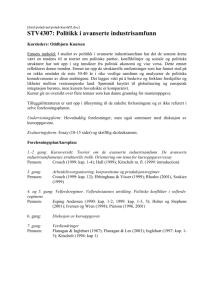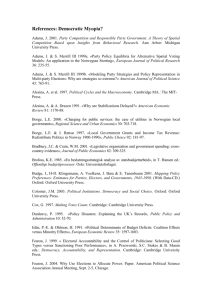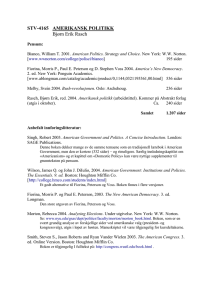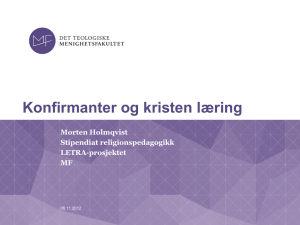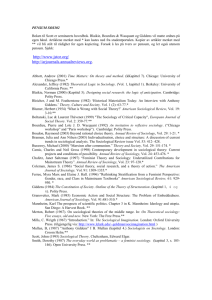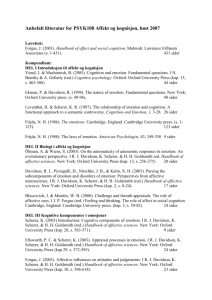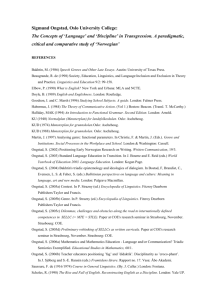Reading list - Mi side - Universitetet i Bergen
advertisement
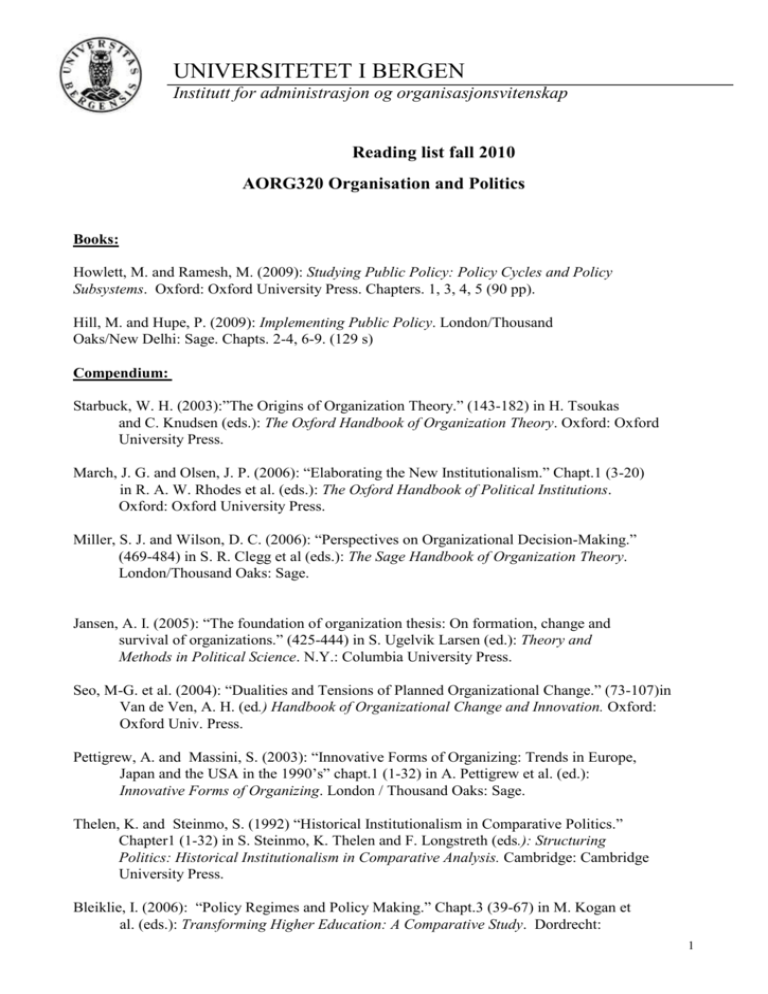
UNIVERSITETET I BERGEN Institutt for administrasjon og organisasjonsvitenskap Reading list fall 2010 AORG320 Organisation and Politics Books: Howlett, M. and Ramesh, M. (2009): Studying Public Policy: Policy Cycles and Policy Subsystems. Oxford: Oxford University Press. Chapters. 1, 3, 4, 5 (90 pp). Hill, M. and Hupe, P. (2009): Implementing Public Policy. London/Thousand Oaks/New Delhi: Sage. Chapts. 2-4, 6-9. (129 s) Compendium: Starbuck, W. H. (2003):”The Origins of Organization Theory.” (143-182) in H. Tsoukas and C. Knudsen (eds.): The Oxford Handbook of Organization Theory. Oxford: Oxford University Press. March, J. G. and Olsen, J. P. (2006): “Elaborating the New Institutionalism.” Chapt.1 (3-20) in R. A. W. Rhodes et al. (eds.): The Oxford Handbook of Political Institutions. Oxford: Oxford University Press. Miller, S. J. and Wilson, D. C. (2006): “Perspectives on Organizational Decision-Making.” (469-484) in S. R. Clegg et al (eds.): The Sage Handbook of Organization Theory. London/Thousand Oaks: Sage. Jansen, A. I. (2005): “The foundation of organization thesis: On formation, change and survival of organizations.” (425-444) in S. Ugelvik Larsen (ed.): Theory and Methods in Political Science. N.Y.: Columbia University Press. Seo, M-G. et al. (2004): “Dualities and Tensions of Planned Organizational Change.” (73-107)in Van de Ven, A. H. (ed.) Handbook of Organizational Change and Innovation. Oxford: Oxford Univ. Press. Pettigrew, A. and Massini, S. (2003): “Innovative Forms of Organizing: Trends in Europe, Japan and the USA in the 1990’s” chapt.1 (1-32) in A. Pettigrew et al. (ed.): Innovative Forms of Organizing. London / Thousand Oaks: Sage. Thelen, K. and Steinmo, S. (1992) “Historical Institutionalism in Comparative Politics.” Chapter1 (1-32) in S. Steinmo, K. Thelen and F. Longstreth (eds.): Structuring Politics: Historical Institutionalism in Comparative Analysis. Cambridge: Cambridge University Press. Bleiklie, I. (2006): “Policy Regimes and Policy Making.” Chapt.3 (39-67) in M. Kogan et al. (eds.): Transforming Higher Education: A Comparative Study. Dordrecht: 1 Springer. Olsen, J. P. and Peters, B.G. (1996) “Learning from Experience?” Chapt.1 (1-35) in J. P. Olsen and B. G. Peters (eds.): Lessons from Experience: Experiential Learning In Administrative Reforms in Eight Democracies. Oslo: Scandinavian University Press. May, P. (2003): “Policy Design and Implementation.” Chapt.17 (223-233) in B. G. Peters and J. Pierre (eds.): Handbook of Public Administration. London: Sage. Christensen, T. and Lægreid, P. (2006): “Rebalancing the State: Reregulation and the reassertion of the Centre.” Chapt.13 (359-380) in T. Christens and P. Lægreid (eds.): Autonomy and Regulation: Coping with Agencies in the Modern State. Cheltenham, UK / Northhampton, USA: Edward Elgar. Hanf, K. and Jansen, A. I. (1998): “Environmental Policy – The outcome of strategic action and institutional characteristics.” Chapt.1 (1-16) in K. Hanf and A. I. Jansen (eds.): Governance and Environment in Western Europe. Politics, Policy and Administration. Harlow, Essex, UK / N.Y.: Longman. Weaver, K. R. and Rockman, B. A. (1993): “When and How Do Institutions Matter?” Chapt.12 (445-461) in R. K. Weaver and B. A. Rockman (eds.): Do Institutions Matter? Government Capabilities in the United States and Abroad. Washington D.C.: The Brookings Institution. Pollit, C. & Bouckaert, G. (2004) Public Management Reform: A Comparative Analysis. Kap. 2 & 3 (38s). Bovens, M. m.fl. (2006): “The Politics of Policy Evaluation” Chapt. 15 in The Oxford Handbook of Public Policy. (16s) Gregory, R. (2001): “Transforming Governmental Culture: A Sceptical View of New Public Mangement.” In T. Christesen and P. Lægreid (eds): New Public Management: The transformation of ideas and practice Aldershot: Ashgate (231-258) Sætren, H. (2009) “Explaining Radical Policy Change Against all Odds: The Role of Leadership, Institutions, Program Design and Policy Windows.” In J.A. Raffel m.fl.(eds) Public Sector Leadership: International Challenges and Perspectives. Cheltenham: Edward Elgar. (20s) Shue, H. (2006): “Ethical Dimensions of Public Policy.” Chapt. 35 in The Oxford Handboo Of Public Policy. (19s) Articles on My Space, File Storage: Albæk, E. (1996): “Why all this evaluation? Theoretical notes and empirical observations on the functions and growth of evaluation with Denmark as an illustrative case.” The Canadian Journal of Program Evaluation 11 (2) (1-34). Bacharach, P. and Baratz, M. S. (1962): “Two Faces of Power.” The American Political 2 Science Review 56 (4) (947-952). Christensen, T. and Lægreid, P. (2004) “Public Administration Research in Norway: Organization Theory, Institutionalism and Empirical Studies in a Democratic Context.” Public Administration 82 (3) (679-690). Dolowitz, D. and Marsh, D. (2000): “Learning from Abroad: The role of Policy Transfer in Contemporary Policy Making.” Governance 13 (1) (5-24) Dowding, K. (2006): “Three-Dimensional Power: A Discussion of Seven Lukes’ Power: A Radical View.” Political Studies Review 4 (136—145). Gustavsson, S. (1980): “Types of Policy and Types pf Politics.” Scandinavian Political Studies 3 (2) (123-143). Gran, T. (2009): “Land Politics in the new state organization in South Africa.” Development Southern Africa 26 (1) (3-16). Hall, P. A. and Taylor, R. C .R. (1996) “Political Science and the Three New Institutionalism.” Political Studies XLIV (933-957). Hill, K. Q. (1997): “In Search of Policy Theory.” Policy Currents 7 (April) (1-9). Lægreid, P. (2007) ”Organization theory – the Scandinavian way.” Nordiske OrganisasjonsStudier 9 (1) (77-82) Linder, S. H. and Peters, B.G. (1989): “Instruments of Government: Perceptions and Contexts.” Journal of Public Policy 9 (1) (35-58). Lundquist, L.J. (2001): “Implementation from Above. The Ecology of Power in Sweden’s Environmental Governance.” Governance 14 (3) (319-337). Olsen, J. P. (1997): “Institutional Design in Democratic Contexts.” The Journal of Political Philosophy 5 (3) (203-229) Olsen, J. P. (2007) “Organization theory, public administration, democratic governance.” Nordiske OrganisasjonsStudier 9 (1) (93-110) Peters, B. G. and Pierre, J. (2001): “Developments in Intergovernmental Relations: Towards a Multi-Level Governance.” Policy & Politics 29 (2) (131-135). Pfeffer, J. (1992): “Understanding Power in Organizations.” California Management Review 34 (2) (29-50). Rhodes, R.A.W. (1996): “The New Governance: Governing without Government.” Political Studies XLIV (15s) Schick, A. (1998): “Why Most Developing Countries Should Not Try New Zealand Reforms.” The World Bank Research Observer 13 (1) (1-9). Scott, W. R. (2004): “Reflections on a Half-Century of Organizational Sociology.” Annual Review of Sociology 30 (1) (1-21). Sørensen, E. & Torfing, J. (2005): “Network Governance and Post-Liberal Democracy.” 3 Administrative Theory & Praxis 27 (2) (197-237). Thomas, J. W. and Grindle, M. S. (1990): “After the Decision: Implementing Policy Reforms in Developing Countries.” World Development 18 (8) (1163-1181). Tilly, C. (2007) “Grudging Consent.” The American Interest. Vol.3, Number 1, September – October 2007 (7s). Todd, P. M. and Gigerenzer, G. (2000): “Pricis of Simple Heuristics that make us smart.” Behavioral and Brain Sciences 23 (727-741). _____________________________________________________________________________ 4
